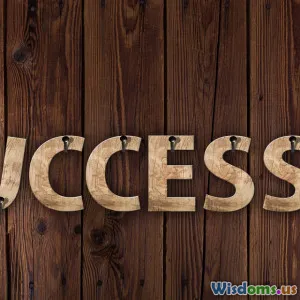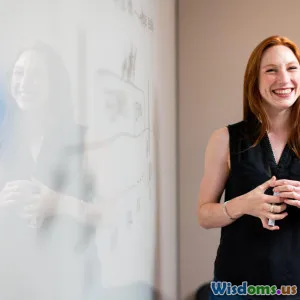
Mapping Career Paths Five Steps to Future Success
13 min read Discover a practical five-step guide to mapping your career path and achieving long-term professional success. (0 Reviews)
Mapping Career Paths: Five Steps to Future Success
Success rarely happens by accident. Whether you’re a student preparing to enter the workforce, a professional seeking advancement, or someone contemplating a career change, having a strategic approach to your professional journey is essential. Career mapping empowers you to turn abstract goals into actionable steps, putting you firmly in the driver’s seat of your destiny. In this guide, we’ll break down a comprehensive five-step process to mapping your career path for long-term success—supported by real-world examples and practical techniques to help you thrive.
Assessing Your Starting Point

Great journeys start with understanding where you’re beginning. Performing a candid self-assessment is fundamental. Start by inventorying your current skills, strengths, and interests.
Why Self-Assessment Matters: Many people skip this step, jumping straight into applying for jobs or seeking promotions. However, without a grounded sense of your abilities and what truly motivates you, it’s easy to drift or chase roles that don’t fit your talents or goals.
Tools and Methods for Self-Assessment:
- SWOT Analysis: Write down your Strengths, Weaknesses, Opportunities, and Threats. For example, an IT specialist might list strong coding skills (strength), lack of leadership experience (weakness), the rise of cloud computing (opportunity), and job automation (threat).
- Skill Inventories: Use platforms like LinkedIn to audit the key skills in your field, then gauge your proficiency against these benchmarks.
- Personality Assessments: Tools such as the Myers-Briggs Type Indicator or Gallup StrengthsFinder help uncover what environments and tasks energize you.
- Feedback from Others: Don’t underestimate peer or manager feedback. A friend might point out a hidden communication talent, or a manager could suggest you’re a natural at project management.
Real-World Example:
Monica, a product designer, realized after a self-assessment that her true strengths lay in research and user empathy—prompting her to shift toward UX research, a specialization that was a much better fit for her natural skills.
Defining a Vision for Success

Once you know your starting point, it’s time to clarify your destination. Having a well-defined vision is like setting your GPS: it keeps you motivated and resilient in the face of setbacks.
Crafting Your Vision Statement:
This can be as broad or as specific as you like. Picture your life in five or ten years. What kind of work energizes you? What lifestyle are you aiming for—flexibility, leadership, creativity, contribution?
- Mind Mapping: Start with a central idea (“My Future Career”) and branch out with related goals (industry, role, lifestyle, impact).
- Vision Boards: Many people find creating a physical vision board with images and words increases daily motivation.
- SMART Goals: Ensure your goals are Specific, Measurable, Achievable, Relevant, and Time-bound. Instead of “I want to lead a team,” try: “Within three years, I want to be a team leader managing five direct reports in a digital marketing agency.”
Actionable Example:
Javier, a finance analyst, realized he wanted more purpose in his work. His vision was to lead finance teams in a mission-driven nonprofit within five years. Mapping this vision gave his daily work a sense of direction, influencing the projects and skills he pursued.
Identifying and Exploring Pathways

With goals in mind, it’s time to chart the possible routes that bridge today’s reality and tomorrow’s ambitions.
Research Career Pathways:
- Informational Interviews: Reach out on LinkedIn or through alumni networks to professionals working in roles you aspire to. Ask about their journeys and what skills mattered most. According to LinkedIn’s 2023 Workforce Report, 85% of jobs are filled via networking—insightful conversations can reveal hidden opportunities.
- Check Professional Roadmaps: Many industries have well-defined pathways (e.g., engineer → senior engineer → manager). But in emerging or interdisciplinary fields, charting your own route may be necessary. Consulting platforms like O*NET Online or the U.S. Bureau of Labor Statistics lets you see typical career ladders.
- Upskill Strategically: Identify the credentials, experiences, or certifications you’ll need. For example, project management aspirants might target a PMP certification, while data scientists often pursue Python, ML, or analytics bootcamps.
Case in Point:
Priya was interested in a move from marketing to data analytics. She used informational interviews to confirm that learning SQL, Google Analytics, and data visualization tools would make her a competitive candidate—and started building her skills accordingly.
Creating an Actionable Plan

With your path identified, it’s time to convert intentions into real progress.
Break Down Big Goals:
- Short- vs. Long-Term Milestones: Separate what’s achievable in the next 6-12 months (e.g., take a course, earn a certification) from multi-year aspirations (e.g., manage a team, launch a startup).
- Timeline Creation: Use tools like Trello or Asana to build a visual timeline of your milestones. Seeing tasks in sequence ensures steady momentum and clarity on next actions.
- Regular Reviews: Monthly or quarterly check-ins prevent drift. Ask yourself: Am I making measurable progress? Have my dreams or priorities changed?
Examples of Actionable Steps:
- Sign up for a hands-on coding bootcamp within the next month.
- Attend two networking events each quarter related to your target job.
- Shadow a colleague in your next-up role for insights and growth ideas.
Overcoming Barriers:
Everyone faces setbacks—procrastination, fear of failure, lack of resources. Tackling these obstacles head-on is part of the journey:
- Accountability Partners: Tell someone your goals—ideally, someone who will check in and nudge you!
- Celebrate Small Wins: Mark off each achieved milestone, no matter how minor; progress builds confidence.
- Flexibility: The plan is a living document. When life throws curveballs, adjust and keep moving.
Building and Leveraging Your Network

In today’s professional environment, who you know often matters as much as what you can do. Yet, effective networking is much more than exchanging business cards; it’s about creating enduring, mutually beneficial relationships.
Modern Networking Strategies:
- Value-First Approach: Instead of asking for favors, look for ways to offer help, resources, or knowledge. For instance, share an interesting industry article or introduce connections with similar interests.
- Attend Diverse Events: Don’t stick to one type of gathering. Attend workshops, webinars, local meetups, or online forums like product communities and professional Slack groups.
- Build an Online Presence: Your personal brand matters. Regularly posting insights, project updates, or industry news on LinkedIn demonstrates expertise and keeps you top-of-mind for opportunities.
Surprising Statistic:
A 2022 study from HubSpot revealed that 85% of professionals believe relationship-building is key to career success, while 70% found jobs through their connections rather than traditional applications.
Practical Example:
After a layoff, Ethan leveraged his network by reaching out to an array of former colleagues, industry acquaintances, and professional groups—landing a referral to a new role within a month.
Adapting to Change and Continuous Learning

No career map is set in stone. The labor market is dynamic—industries shift, roles evolve, and entirely new disciplines emerge overnight. Thriving in such an environment requires a mindset of perpetual growth.
The Importance of Adaptability:
- Stay Informed: Subscribe to newsletters, listen to relevant podcasts, and follow thought leaders in your field. This keeps you ahead of major trends.
- Invest in Learning: Today, affordable online courses and micro-credentials can keep your skillset fresh. Whether it’s Coursera, Udemy, edX, or company-sponsored workshops, cultivate the habit of regular upskilling.
- Embrace Change: View challenges—like a merger, global crisis, or automation—as invitations to learn new skills and pivot, not as setbacks. For example, many event planners in 2020 shifted focus to virtual event management, using their existing skills in tech-enabled ways.
Real-Life Application:
Amanda, a marketing specialist, realized traditional advertising was declining and digital analytics were on the rise. By proactively learning Google Ads and earning a certification, she future-proofed her career—and was promoted during her company’s digital transition.
Sustaining Motivation Through Reflection and Tracking Success

Career journeys can be long and complex. To maintain momentum, it’s crucial to celebrate progress and reflect。
Develop a Reflection Habit:
- Keep a Career Journal: Document monthly achievements, struggles, and evolving interests. This practice uncovers patterns over time and helps keep goals aligned with changing passions.
- Solicit Feedback: Constructive feedback from mentors, supervisors, or peers steers your growth and provides fresh perspectives.
- Visualize Progress: Many people use habit trackers, checklists, or digital dashboards (like Notion or Excel) to see tangible improvement—and to motivate themselves through inevitable plateaus.
Evidence-based Tip:
Research from the University of California suggests that individuals who regularly visualize and review their goals are 33% more likely to achieve them.
Personal Example:
Leah, aiming for a management role, built in weekly reflections and quarterly feedback sessions with her mentor. This not only accelerated her readiness for new challenges but also helped her course-correct as she discovered new interests.
Crafting a successful career isn’t about luck or chance—it’s about deliberate planning, continuous learning, and building authentic relationships. Using these five steps, you can confidently chart a personalized path to future success, ready to adapt and grow no matter what the future brings. Every journey is unique, but with a clear map, every milestone—big or small—accelerates your progress forth.
Rate the Post
User Reviews
Popular Posts


















